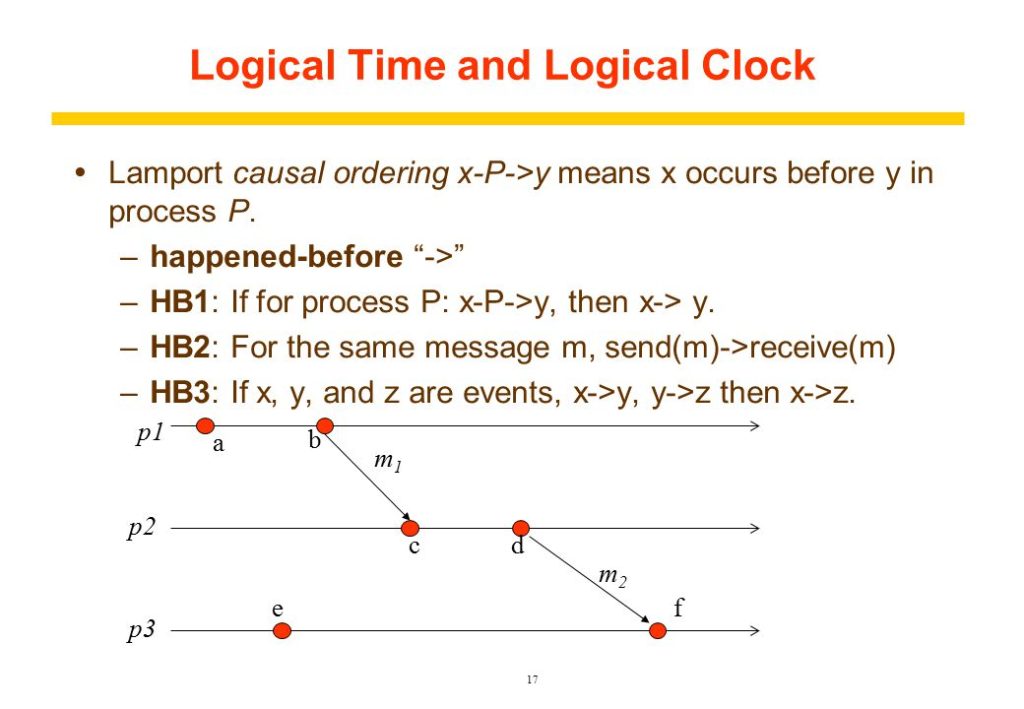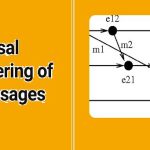Instead of synchronizing clocks, event ordering can be used
If two events occurred at the same process pi (i = 1, 2, … N) then theyoccurred in the
order observed by pi, that is order →i
when a message, m is sent between two processes, send(m) happened before receive(m)
Lamport[1978] generalized these two relationships into the happened-before relation: e →i e’
HB1: if e →i e’ in process pi, then e → e‘
HB2: for any message m, send(m) → receive(m)
HB3: if e → e’ and e’ → e”, then e → e”

Lamport‘s logical clocks
Each process pi has a logical clock Li
a monotonically increasing software counter
not related to a physical clock
Apply Lamport timestamps to events with happened-before relation
LC1: Li is incremented by 1 before each event at process pi
LC2: when process pi sends message m, it piggybacks t = Li
when pj receives (m,t), it sets Lj := max(Lj, t) and applies LC1 before timestamping the event receive (m)
e →e‘ implies L(e)<L(e‘), but L(e)<L(e’) does not imply e→e‘

Totally ordered logical clocks
Some pairs of distinct events, generated by different processes, may have numerically identical Lamport timestamps
Different processes may have same Lamport time
Totally ordered logical clocks
If e is an event occurring at pi with local timestamp Ti, and if e‘ is an event occurring at pj with local timestamp Tj
Define global logical timestamps for the events to be (Ti, i ) and (Tj, j)
Define (Ti, i ) < (Tj, j ) iff
Ti < Tj or
Ti = Tj and i < j
No general physical significance since process identifiers are arbitrary
Vector clocks
Shortcoming of Lamport clocks:
L(e) < L(e’) doesn’t imply e → e’
Vector clock: an array of N integers for a system of N processes
Each process keeps its own vector clock Vi to timestamp local events
Piggyback vector timestamps on messages
Rules for updating vector clocks:
Vi[i]] is the number of events that pi has timestamped
Viji] ( j≠ i) is the number of events at pj that pi has been affected by VC1: Initially, Vi[ j ] := 0 for pi, j=1.. N (N processes)
VC2: before pi timestamps an event, Vi[ i ] := Vi[ i ]+1 VC3: pi piggybacks t = Vi on every message it sends
VC4: when pi receives a timestamp t, it sets Vi[ j ] := max(Vi[ j ] , t[ j ]) for
j=1..N (merge operation)

Compare vector timestamps
V=V‘ iff V[j] = V‘[j] for j=1..N
V>=V‘ iff V[j] <= V‘[j] for j=1..N
V<V‘ iff V<= V‘ ^ V!=V‘
Figure 11.7 shows
a→f since V(a) < V(f)
c || e since neither V(c) <= V(e) nor V(e) <= V(c)


